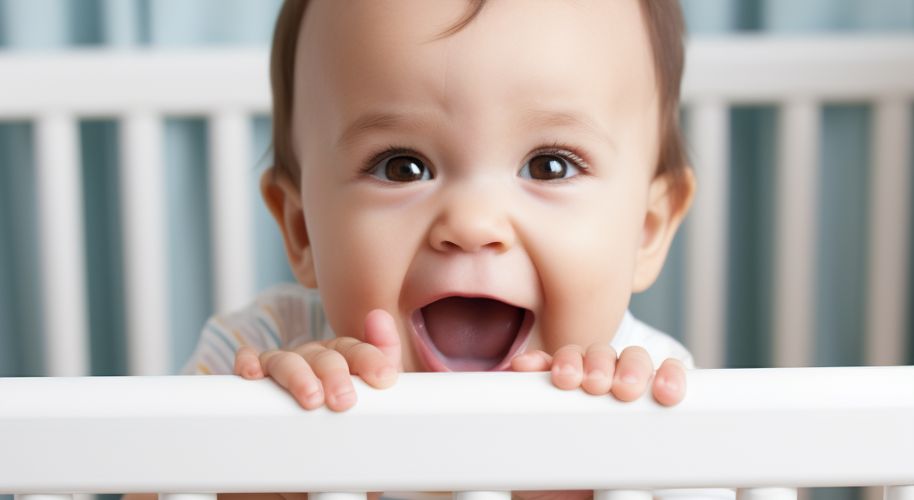Last Updated on June 5, 2025
Babies love to chew on their cribs, especially when teething. As your little one’s pearly whites debut, the instinct to chew and gnaw on anything within reach becomes almost inevitable. However, ensuring this innocent exploration doesn’t become a potential hazard requires effective strategies.
From using teething toys as a soothing solution to safeguarding the crib, we’ll uncover simple strategies that ensure comfort and safety. Let’s learn how to redirect their chewing instincts and create a secure space for your little one.

Putting the Brakes on Baby Crib Chewing: Effective Solutions
Teething is a natural process for babies, but it can lead to unexpected behaviors – including chewing on their cribs. This can raise concerns about the baby’s safety and the longevity of the crib. Here are some effective tips to prevent babies from gnawing on their cribs.
Crib Rail Covers
Crib rail covers serve a dual purpose. They protect the crib from damage and provide a soft surface for your baby to chew on. They are usually easy to attach and remove for cleaning and come in various materials such as fabric, plastic, or silicone. Some even come with cute designs that can add to the decor of your baby’s room.
Teething Toys
Teething toys are designed to be chewed on and can help soothe your baby’s gums. They come in various shapes, sizes, and textures; some can even be refrigerated for relief. Offering these as an alternative can redirect your baby’s attention away from the crib.
Bitter Sprays
Bitter sprays are deterrents that can discourage babies from chewing on their cribs. These sprays have a bitter taste but are harmless and safe for babies. Before using, always check the product label to ensure it’s non-toxic and approved for this type of use.
Cold Compresses
Cold compresses can provide relief to a teething baby’s sore gums. You can make a cold compress by soaking a clean washcloth in water, squeezing out the excess, and then chilling it in the fridge. Before bedtime, gently rub the cold compress on your baby’s gums to help soothe discomfort.
Regularly Checking Baby’s Gums
By regularly checking your baby’s gums, you can keep track of their teething progress. If you notice a new tooth emerging, you can anticipate that your baby might start chewing more – on their hands, toys, and possibly the crib. With this knowledge, you can take preventative measures, like providing teething toys or applying a crib rail cover.
Unlocking the Mystery: Why Do Infants Munch on Their Cribs?
The sight of babies chewing on their cribs may seem curious and puzzling, but there’s a simple explanation behind it. As infants begin to teethe, their gums can become sore and uncomfortable. Chewing on objects, like cribs, relieves them from this discomfort.
Teething is a natural process that usually starts around six months of age. During this time, a baby’s first set of teeth, milk teeth, begin to push through their gums. This can be uncomfortable and even painful for them. Chewing on things is an instinct that helps alleviate some of this soreness.
Their sturdy rails and edges make cribs convenient and accessible for babies to chew on. Babies explore the world around them through their mouths, and a crib is a perfect target for their tiny teeth. The firmness of the crib’s surface offers counter-pressure to their gums, which can provide temporary relief.
It’s important to note that while crib chewing is normal and a common behavior among teething babies, some precautions should be taken. Providing safe alternatives, such as teething toys designed to soothe their gums, can redirect their chewing habit away from the crib. These toys are made to be safe for babies to chew on and can provide effective relief.
The mystery behind why infants chew on their cribs is unraveled by understanding the discomfort of teething. Chewing on the crib rails offers a simple way for babies to ease their sore gums. Parents can ensure their baby’s comfort and safety during this natural development phase by offering appropriate teething toys and closely monitoring crib conditions.
You Might also Like These Resources!
- When Your Baby Has Outgrown the Bassinet but Isn’t Ready for a Crib
- Top Baby Swing for Colic [Newest Reviews]
The Risks Of Babies Chewing On Their Cribs

Babies chewing on their cribs is a common behavior, often associated with teething discomfort. However, this habit can pose several risks to their health and safety.
- Suffocation Risk: One of the primary concerns is the risk of suffocation. Wide covers that protect crib rails could become untied and pose a suffocation hazard if draped over the baby.
- Ingestion of Paint or Varnish: Additionally, there’s a risk of paint or varnish ingestion. Many cribs are painted or varnished, and babies may ingest these materials when they chew on them. This is concerning as some paints and varnishes can contain harmful chemicals.
- Ingestion of Wood Splinters: If the baby has teeth, they might bite off and ingest splinters from the wooden crib, leading to potential choking or injuries inside the mouth.
- Consult a Pediatrician: If persistent crib-chewing continues, it’s advisable to consult a pediatrician to rule out any potential underlying issues.
How Can I Pick the Perfect Crib for My Baby?
Choosing the right crib for your baby involves several considerations:
- Safety Standards: Ensure the crib meets safety standards. For instance, in the US, cribs should meet the Consumer Product Safety Commission (CPSC) standards.
- Slats: The crib slats should be no more than 2 3/8 inches apart to prevent the baby’s head from slipping through.
- Adjustable Mattress Height: As your baby grows, you’ll need to lower the mattress. A crib with an adjustable mattress height is beneficial.
- Stability: Check the crib’s stability. It shouldn’t wobble or rattle when you shake it.
- Corner Posts: If the crib has corner posts, they should be at most 1/16th of an inch unless they’re over 16 inches high to support a canopy.
- No Cutouts: The headboard and footboard should not have cutouts, which could trap your baby’s head.
- Mattress Fit: The mattress should fit snugly within the crib. No gaps should be larger than two fingers between the mattress and the crib.
- Crib Bumpers: Avoid cribs with bumpers as they risk suffocation, strangulation, or entrapment.
FAQs
How to remove bite marks On A crib?
To remove bite marks on a crib, you can leverage the natural swelling property of most woods. Wet a washcloth and place it on the affected area to moisten and heat the wood. If this doesn’t raise the teeth marks, you can fill the dents using a wax stick or wood putty. After it dries, sand the area for a smooth finish. It’s also possible to sand the entire rail and repaint it.
Is Baby Crib Paint Harmful?
As for baby crib paint, it is generally safe if it’s specifically made for cribs or children’s rooms. These paints are typically non-toxic and free from harmful chemicals.
How do you install crib teething guards?
Installation methods vary by brand and type. Usually, they easily attach to the crib rails using adjustable straps, ties, or snaps. Follow the included instructions for a secure fit.
Final Words
To stop babies from chewing on cribs, it’s important to know why they do it. Teething makes their gums hurt, so they chew for relief. Giving them special teething toys is a good idea. These toys are safe to chew and help their gums feel better. Babies with toys to chew on are less likely to chew on the crib.
Also, check the crib often to make sure it’s safe. If you see any damage, fix it so the crib stays strong. By understanding their needs and giving them the right things to chew on, we can keep babies happy and safe as they grow.
You Might Also Like These Latest Content!
- Exploring the Anatomy of Baby Teeth: Do They Have Roots?
- Can Babies Safely Drink Distilled Water?
- When Your Baby Has Outgrown the Bassinet but Isn’t Ready for a Crib

Dr. Leah Alexander is a board-certified general pediatrician who has been in practice for over 20 years. She began working as a pediatrician at Elizabeth Pediatric Group of New Jersey in 2000. Since 2005, she has been working as an independently contracted pediatrician with Medical Doctors Associates at Pediatricare Associates of New Jersey. Read more
